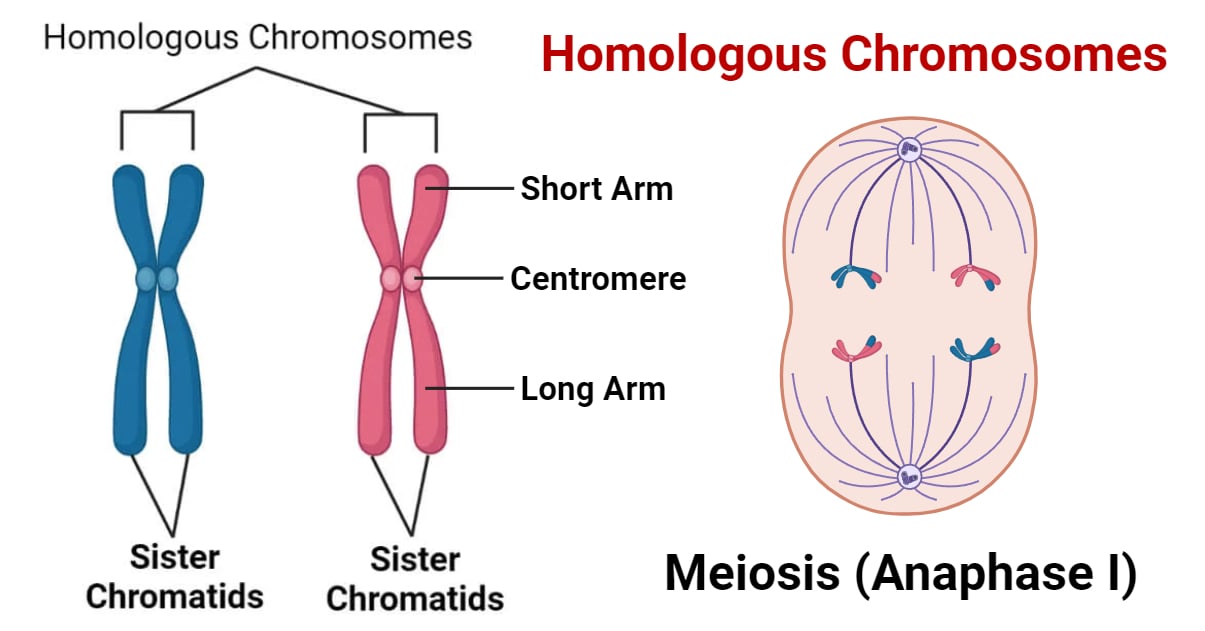Chromosomes are essential components of the genetic material located in the nucleus of cells. They are thread-like structures that consist of DNA and proteins. Homologous chromosomes, also known as homologs, are pairs of chromosomes within the same cell that share similar structural characteristics, like length, shape, centromere position, and genetic content. These homologous pairs carry genes that correspond to the same loci on the chromosome, meaning they hold the same set of genes.

Understanding homologous chromosomes helps us understand the patterns of genetic inheritance. Homologous chromosomes are vital in sexual reproduction, determining our physical traits and individual characteristics. When we inherit genetic material from our parents, we receive one homolog from each parent for each chromosome pair, creating a unique combination of genes from both parents. This recombination provides diversity within a population.
There are 46 chromosomes in humans, with 22 pairs of autosomes and one pair of sex chromosomes. Autosomes are homologous chromosomes. In the case of sex chromosomes, females (XX) have homologous sex chromosomes, while males (XY) have non-homologous sex chromosomes.
Interesting Science Videos
Characteristics of Homologous Chromosomes
- Homologous chromosomes share a similar structure, including gene sequence, gene loci, centromere position, and chromosomal length.
- While homologous chromosomes carry the same genes, they may have different alleles.
- Homologous chromosomes are found in diploid organisms, which have two sets of chromosomes.
- Each homologous chromosome pair contains one chromosome inherited from the mother and another from the father.
- During meiosis, homologous chromosomes may exchange segments of genetic material through a process called crossing over or recombination.
- The recombination of genetic material between homologous chromosomes during meiosis promotes genetic diversity in offspring.
- Through meiosis, homologous chromosomes undergo recombination, leading to the formation of haploid gametes with one set of chromosomes.
Homologous chromosome pairing during meiosis
Homologous chromosomes pair up and are distributed during meiosis. Homologous chromosome pairing is an important process in meiosis that promotes genetic recombination and proper segregation of homologs.
- Sister chromatids: Before homologous chromosomes pair up during meiosis, each chromosome in the diploid cell undergoes DNA replication during the S phase of the cell cycle, creating two identical copies called sister chromatids.
- Meiosis is a cell division in sexually reproducing organisms that form gametes (sperm and egg cells). It consists of two divisions: Meiosis I and Meiosis II.
- In Meiosis I, homologous chromosomes come together and exchange genetic material through crossing over or recombination. This exchange of genetic material promotes genetic variation, as each homologous chromosome carries a unique combination of genes from both parents. After crossing over, the homologous chromosomes separate into two different cells.
- In Meiosis II, the chromatids of the separated homologous chromosomes are further divided, resulting in the formation of four haploid cells, also known as gametes, that contain half the number of chromosomes present in the starting cell.
- Synapsis: During prophase I of meiosis, homologous chromosomes are paired together. This process is called synapsis. This is facilitated by the synaptonemal complex, a protein structure that helps in alignment and recombination between homologous chromosomes.
- Recombination involves the exchange of genetic material between homologous chromosomes.
- Chiasmata: When crossing over occurs, the two homologous chromosomes become physically connected at specific points along their lengths, forming X-shaped structures called chiasmata.
- Recombination events do not occur uniformly throughout the genome. It occurs more frequently in gene-rich euchromatin regions and occurs at specific sites called recombination hotspots.
- Most organisms use both the synaptonemal complex and crossovers to hold homologs together. However, some species use only one of these mechanisms.
- The processes of homolog identification, pairing, and recombination in meiosis contribute to genetic diversity and proper chromosome segregation.
Nondisjunction
Nondisjunction is a process that occurs when chromosomes do not separate correctly during cell division. It results in an abnormal number of chromosomes in daughter cells. It can occur during mitosis or meiosis.
- During meiosis, there can be instances when chromosomes do not separate correctly, leading to nondisjunction.
- In this abnormal meiotic division, some haploid cells end up with missing chromosomes, while others have extra copies.
- As a result, the gametes formed from these abnormal divisions can give rise to embryos with genetic abnormalities.
- Many of these embryos do not survive, but some can develop into individuals with conditions like Down syndrome in humans which is caused by an extra copy of chromosome 21 due to nondisjunction during meiosis.
Significances of Homologous Chromosomes
- Homologous chromosomes play an important role in sexual reproduction, allowing offspring to be genetically different from their parents.
- During meiosis, homologous chromosomes exchange genes through recombination, promoting genetic variation in offspring.
- Sexual reproduction with homologous chromosome exchange results in a larger gene pool, providing a higher chance of acquiring beneficial genes.
- Greater genetic variation enhances an organism’s ability to adapt to changing environments and improves biological survival.
- Homologous chromosomes are also useful in repairing double-strand breaks in DNA.
- Understanding homologous chromosomes is important for studying and diagnosing genetic disorders caused by irregular pairing and separation of homologs.
References
- 11.1: The Process of Meiosis – Biology LibreTexts
- Alberts, B., Johnson, A., Lewis, J., et al. (2002) Molecular Biology of the Cell. 4th Edition. Garland Science, New York. https://www.ncbi.nlm.nih.gov/books/NBK26840/
- Bailey, Regina. “A Genetics Definition of Homologous Chromosomes.” ThoughtCo, Apr. 5, 2023, thoughtco.com/homologous-chromosomes-definition-373469.
- Genetics, Nondisjunction – StatPearls – NCBI Bookshelf (nih.gov)
- Gerton, J. L., & Hawley, R. S. (2005). Homologous chromosome interactions in meiosis: diversity amidst conservation. Nature Reviews Genetics, 6(6), 477–487. doi:10.1038/nrg1614
- Helmenstine, Anne Marie, Ph.D. “What Is Synapsis? Definition and Function.” ThoughtCo, Aug. 29, 2020, thoughtco.com/synapsis-definition-and-function-4795794.
- Homologous Chromosome – Structure and Function (byjus.com)
- Mitosis, Meiosis, and Fertilization (utah.edu)

CAN YOU THROW SOME LIGHT ON NUDIBRANCHS & LIZARD REPRODUCTION ?